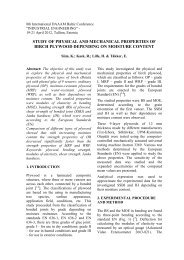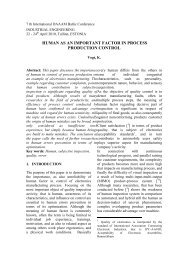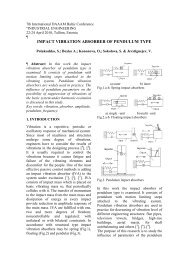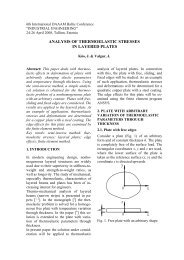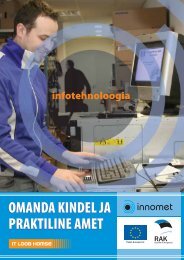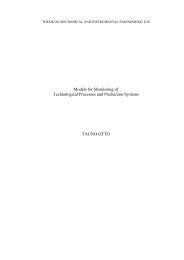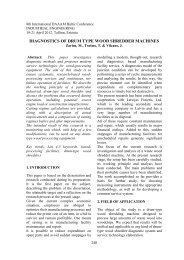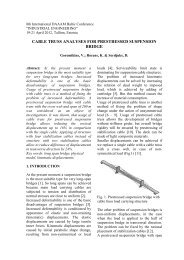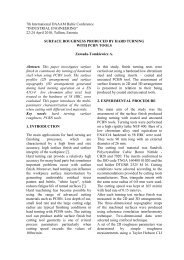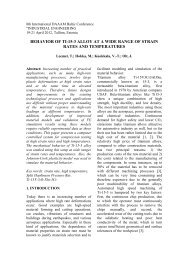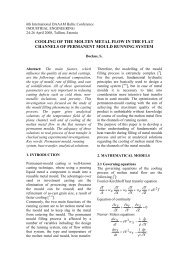Development of Intelligent Model for Estimating Manufacturing Cost ...
Development of Intelligent Model for Estimating Manufacturing Cost ...
Development of Intelligent Model for Estimating Manufacturing Cost ...
You also want an ePaper? Increase the reach of your titles
YUMPU automatically turns print PDFs into web optimized ePapers that Google loves.
7th International DAAAM Baltic Conference<br />
INDUSTRIAL ENGINEERING<br />
22-24 April 2010, Tallinn, Estonia<br />
DEVELOPMENT OF INTELLIGENT MODEL FOR ESTIMATING<br />
MANUFACTURING COST IN SHEET METALWORKING<br />
Rimašauskas, M.; Bargelis, A.<br />
Abstract: In modern manufacturing, high<br />
product quality, manufacturing flexibility<br />
and low production cost are main keys to<br />
competitiveness. For this reason,<br />
manufacturing cost is always the point <strong>of</strong><br />
primary concern.<br />
Basically, the manufacturing cost <strong>of</strong> a<br />
sheet metal part is determined by its shape<br />
complexity, perimeter, size, a number <strong>of</strong><br />
design features, material properties and<br />
thickness. If these data can be obtained<br />
and considered in a design stage,<br />
estimation <strong>of</strong> manufacturing cost during<br />
the early design stage will be a feasible<br />
task.<br />
This research submits a framework <strong>for</strong><br />
estimating the manufacturing cost in sheet<br />
metalworking. The manufacturing cost<br />
estimation method is based on Artificial<br />
Neural Networks (ANN). ANN is helpful in<br />
the situations when conventional linear<br />
regression does not work.<br />
The obtained results have been considered,<br />
discussed and appropriate conclusions<br />
have been drawn.<br />
Key words: neural network, cost<br />
<strong>for</strong>ecasting, laser cutting.<br />
1. INTRODUCTION<br />
In recent years, the importance <strong>of</strong><br />
manufacturing cost estimation has greatly<br />
increased. It is determined not only by the<br />
growth <strong>of</strong> production but by the rise <strong>of</strong><br />
energy resources and material costs as<br />
well. It is interconnected with the<br />
competition which has up surged in all<br />
fields, in a production sector especially.<br />
Moreover, variety <strong>of</strong> products has<br />
immensely increased, thus aggravating the<br />
manufacturing cost <strong>for</strong>ecasting at an early<br />
production stage <strong>of</strong> a product.<br />
1.1 Survey <strong>of</strong> manufacturing cost<br />
estimation methods<br />
Nowadays, in many cases researchers<br />
publish their methods developed <strong>for</strong><br />
<strong>for</strong>ecasting the manufacturing cost at an<br />
early production stage <strong>of</strong> a product. In<br />
2002, J.Jung published his work on<br />
manufacturing cost <strong>for</strong>ecasting based on<br />
splitting a machine part into design<br />
features [ 1 ]. Furthermore, he emphasizes<br />
that manufacturing cost <strong>for</strong>ecasting is the<br />
main task <strong>of</strong> an enterprise and it is to be<br />
accomplished at an early product design<br />
stage by applying virtual manufacturing<br />
methods. The author, however, presents the<br />
model <strong>of</strong> manufacturing cost estimation <strong>of</strong><br />
the products being turned and milled only.<br />
A.Smith et al. analyze the advantages and<br />
shortcomings <strong>of</strong> neural networks and<br />
regression in estimating manufacturing<br />
costs. Their conclusions say that neural<br />
networks can suitably replace regression<br />
used <strong>for</strong> estimating the manufacturing cost<br />
[ 2 ]. Their other article, analyzing laser<br />
cutting and CNC cutting technologies,<br />
proposes a parametric model <strong>for</strong><br />
<strong>for</strong>ecasting the manufacturing cost in sheet<br />
metalworking industry [ 3 ]. Literature on<br />
this subject presents various attempts to<br />
classify the manufacturing cost <strong>for</strong>ecasting<br />
models according to the applied methods,<br />
the main <strong>of</strong> them being [ 4 ]:<br />
• Parametric cost <strong>for</strong>ecasting;<br />
• Forecasting by applying artificial<br />
intelligence;
• Forecasting based on experts’<br />
experience;<br />
• Forecasting by means <strong>of</strong> knowledgebases;<br />
• Forecasting by means <strong>of</strong> classifiers.<br />
1.2 Survey <strong>of</strong> application <strong>of</strong> an artificial<br />
intelligence method<br />
The origin <strong>of</strong> artificial intelligence is<br />
related to the work <strong>of</strong> Samuel and Neweek<br />
in 1960, when self-contained game playing<br />
and solution seeking programs were being<br />
developed [ 5 ]. Whereas, A. Gunasekaran in<br />
his paper on productivity and quality<br />
improvement issues states that the latter are<br />
toughly related to production automation<br />
and up-dating, i.e. they are necessarily<br />
connected to the application <strong>of</strong> expert<br />
systems (ES) and artificial intelligence [ 6 ].<br />
In 1998, Manfred Geiger with his<br />
colleagues published an article on<br />
application <strong>of</strong> neural networks to a large<br />
scale production <strong>of</strong> sheet metal parts [ 7 ].<br />
Actually, they analyzed manufacturing cost<br />
<strong>of</strong> products produced by conventional<br />
sheet-metal stamping. In their conclusions<br />
the authors say that application <strong>of</strong> neural<br />
networks makes it possible to estimate the<br />
cost at an early production stage. Neural<br />
networks enable the <strong>for</strong>ecasting precision<br />
to be from 5 to 15%. In 2001, Q.Wang and<br />
D. Stockton presented their manufacturing<br />
cost model based on artificial neural<br />
networks making it possible to <strong>for</strong>ecast the<br />
turning operation cost [ 8 ]. The authors<br />
highlight the advantages <strong>of</strong> their models<br />
emphasizing that the effect <strong>of</strong> the model<br />
depends on accuracy and amount <strong>of</strong><br />
primary data. Their following article<br />
presents the model with DSS containing<br />
neural network <strong>for</strong> production quality<br />
assurance [ 9 ]. In 1998, Y. Zhang and his<br />
co-authors had introduced a neural network<br />
approach to cost <strong>for</strong>ecasting and practically<br />
they applied it to an early cost estimation<br />
<strong>of</strong> packaging products [ 10 ]. M. Barletta and<br />
co-authors applied the neural network<br />
model to simulation <strong>of</strong> thin sheets<br />
<strong>for</strong>mation. In that case neural networks<br />
help <strong>for</strong>ecast permanent sets and the <strong>for</strong>ce<br />
to be used in the <strong>for</strong>mation process [ 11 ].<br />
According to the authors, neural networks<br />
can be applied to the solution <strong>of</strong> such nonlinear<br />
problems. F. Meziane and his coauthors<br />
have comprehensively described<br />
the possibilities <strong>of</strong> neural network<br />
application to industrial engineering. They<br />
state that neural networks are appropriate<br />
to classification and optimization and<br />
accentuate their advantages in image<br />
identification and quality control [ 12 ]. That<br />
article emphasizes the benefit gained from<br />
applying various artificial intelligence tools<br />
such as fuzzy logic, expert systems, genetic<br />
algorithms, knowledge base systems to<br />
mechanical engineering. B. Al-Najjar and<br />
I.Alsyouf recommend using an artificial<br />
intelligence method in quality assurance.<br />
They say that artificial neural networks,<br />
fuzzy logic and expert systems have really<br />
helped the systems become adaptive,<br />
learning and knowledge based [ 13 ].<br />
2. DEVELOPMENT OF<br />
MANUFACTURING<br />
COST<br />
ESTIMATION MODEL<br />
An important point <strong>of</strong> production<br />
efficiency estimation is estimating<br />
manufacturing costs with respect to<br />
product characteristics and a per<strong>for</strong>med<br />
technological process. The <strong>for</strong>mer cost<br />
<strong>for</strong>ecasting parametric model estimated the<br />
manufacturing costs with sufficient<br />
accuracy [ 3 ]. Nevertheless, its basic<br />
drawback was extracting <strong>of</strong> product<br />
parameters and their submission to the<br />
model. That process was done by an<br />
engineer. In the above given survey it is<br />
evident that a neural network model may<br />
be used in costs prediction. A newly<br />
developed model based on neural networks<br />
contains an integrated module extracting<br />
the geometric parameters <strong>of</strong> sheet metal<br />
products, thus enabling specialists to<br />
quicken the cost estimation process.<br />
Extraction <strong>of</strong> the product geometric<br />
parameters is based on determination <strong>of</strong><br />
sheet parts contour parameter, internal
holes parameter and the quantity <strong>of</strong> design<br />
features from the graphic data file. To<br />
estimate the manufacturing costs an<br />
intelligent model based on neural networks<br />
has been developed. In enterprises the<br />
time-span and parameters <strong>of</strong> standard parts<br />
produced by separate equipment are stored<br />
in the data base. This in<strong>for</strong>mation is used<br />
when making the structure <strong>of</strong> a neural<br />
network. The advantage <strong>of</strong> an intelligent<br />
model based on neural networks lies in the<br />
fact that a network <strong>of</strong> a properly selected<br />
structure can approximate any continuous<br />
function.<br />
CAD model or graphic <strong>for</strong>mat file<br />
Part parameter<br />
Material Number <strong>of</strong> DF<br />
Contour length<br />
Part complexity<br />
Material thickness<br />
this case a developed extraction module <strong>of</strong><br />
parts graphic parameters will be used. The<br />
following significant step is selection <strong>of</strong> a<br />
neural network structure. Theoretically, a<br />
neural network with one hidden layer<br />
containing sufficient neurons <strong>of</strong> that layer<br />
can approximate any continuous function.<br />
In practice, neural networks with one or<br />
two hidden layers are most frequently used.<br />
Neurons <strong>of</strong> a hidden layer are selected<br />
experimentally.<br />
To solve the task a two layer neural<br />
network is sufficient. The structure <strong>of</strong> a<br />
neural network consists <strong>of</strong> a one hidden<br />
layer <strong>of</strong> neurons, an input layer and an<br />
output layer. In a hidden layer a hyperbolic<br />
tangent transfer function is used:<br />
(1)<br />
and in an output layer a linear transfer<br />
function is used. The one neuron transfer<br />
function may be expressed as follows:<br />
Neural network structure<br />
...<br />
Estimated manufacturing time<br />
here x 1 – x n – neuron input values, w 1 – w n<br />
– weight values, b – displacement. A<br />
neural network is <strong>for</strong>med <strong>of</strong> several layers<br />
with interconnected neurons. Mathematical<br />
model <strong>of</strong> a two layer neural network may<br />
be expressed as follows:<br />
Work center cost<br />
Estimated manufacturing cost<br />
Fig. 1. Structure <strong>of</strong> cost <strong>for</strong>ecasting model<br />
A network input layer is <strong>for</strong>med <strong>of</strong> the<br />
following part parameters: thickness,<br />
number <strong>of</strong> design features, material, and<br />
perimeter <strong>of</strong> a contour being cut. The input<br />
parameters may be obtained either from 3D<br />
CAD systems or the special s<strong>of</strong>tware; in<br />
here X – matrix <strong>of</strong> input values, W 1 –<br />
matrix <strong>of</strong> the first layer weight values, W 2<br />
– matrix <strong>of</strong> the second layer weight values,<br />
Y - matrix <strong>of</strong> output values, w i – weights<br />
<strong>of</strong> the second layer neurons, w j – weights<br />
<strong>of</strong> the first layer neurons, x j – input values,<br />
f 1 – hyperbolic tangent function, f 2 – linear<br />
transfer function.
Learning <strong>of</strong> neural networks is based on<br />
the error minimization methods. Here sum<br />
square error (SSE) minimization methods<br />
are used. SSE is obtained by summing the<br />
errors in all network derivatives <strong>for</strong> the<br />
whole data sample set.<br />
Selecting a neural network, the following<br />
parameters have been used: tested network<br />
with one hidden layer, a number <strong>of</strong> neurons<br />
in a hidden layer varied from 2 to 10<br />
neurons.<br />
than critical Student’s t-test criterion value<br />
2.042 and it may be stated that a zero<br />
hypothesis is confirmed and the difference<br />
between the means with confidence <strong>of</strong> 95%<br />
probability is statistically insignificant. In<br />
this way, the selected neural network<br />
structure with seven neurons in a latent<br />
layer is the best.<br />
In order to find the best threshold values,<br />
50 neural networks <strong>of</strong> the same structure<br />
are to be generated changing their<br />
threshold values. Fig. 3 shows that the best<br />
selected threshold values are in the 25 th<br />
network.<br />
Fig. 3. Selection <strong>of</strong> the best neural<br />
network structure <strong>for</strong> AMADA equipment<br />
Fig. 2. Identification <strong>of</strong> hidden neural<br />
quantity <strong>for</strong> AMADA equipment<br />
Figure 2 indicates that the best neuron<br />
network structure <strong>for</strong> AMADA equipment<br />
is 7 neurons in a hidden layer. In this case<br />
neural network <strong>of</strong> a moderate structure and<br />
the lowest mean <strong>of</strong> SSE are obtained. The<br />
neural network <strong>of</strong> a smaller structure is<br />
chosen because it preferably generalizes<br />
the data. If you want to estimate the<br />
difference between the usage <strong>of</strong> seven and<br />
nine neurons network, you have to<br />
calculate Student’s t-test criterion.<br />
In calculation, the taken significance level<br />
p will be equal to 0.05. The obtained<br />
Fisher’s criterion t = 0.000122 is lower<br />
than 2p, and it is possible to state that the<br />
difference between dispersions is<br />
statistically significant. The obtained<br />
Student’s t-test criterion t = 0.264 is lower<br />
Figure 4 illustrates that the best neural<br />
network <strong>for</strong> Bystronic equipment is with 7<br />
neurons in a hidden layer.<br />
Fig. 4. Identification <strong>of</strong> hidden neurons<br />
quantity <strong>for</strong> Bystronic equipment
Figure 5 shows that the best threshold<br />
values have been selected with a second<br />
try. A neural network <strong>of</strong> that structure is<br />
stored and further experiments have been<br />
made with it.<br />
Fig. 6. Comparison <strong>of</strong> manufacturing costs<br />
<strong>for</strong>ecasting models by using AMADA laser<br />
cutting lathe<br />
Analogically, a manufacturing cost<br />
<strong>for</strong>ecasting model has been developed and<br />
tested using 3 kW Bystronic equipment.<br />
Fig. 5. Selection <strong>of</strong> the best neural network<br />
structure <strong>for</strong> Bystronic equipment<br />
3. CASE STUDY<br />
In this section the operation <strong>of</strong> a developed<br />
intelligent model is examined. In an above<br />
mentioned article a parametric<br />
manufacturing cost estimation model and<br />
its reliability have been positively<br />
evaluated [3]. The results <strong>of</strong> that model<br />
have been compared to those <strong>of</strong> the<br />
<strong>for</strong>merly presented parametric model. As<br />
seen from Fig. 6, the model based on<br />
neural networks estimates the<br />
manufacturing costs fairly accurately<br />
compared to a parametric model.<br />
Fig. 7. Comparison <strong>of</strong> manufacturing cost<br />
<strong>for</strong>ecasting models by using Bystronic<br />
equipment<br />
Figure 7 illustrates the results <strong>of</strong> different<br />
manufacturing cost <strong>for</strong>ecasting models<br />
intended <strong>for</strong> a three kilowatt cutting<br />
equipment. It is evident that production<br />
time differs slightly except modelling <strong>of</strong><br />
the 16 th part. It can be explained that the<br />
16 th part perimeter is the largest, over<br />
10,000 mm. When developing this model<br />
based on neural networks, the parts with<br />
perimeters over 6,000 mm have not been<br />
suitably tested. As seen from graphs given<br />
in Figs 6 and 7, an error <strong>of</strong> the results <strong>of</strong><br />
<strong>for</strong>ecasting models based on neural<br />
networks compared to those <strong>of</strong> parametric<br />
models is up to 10%.<br />
4. CONCLUSIONS<br />
A developed model <strong>of</strong> <strong>for</strong>ecasting<br />
manufacturing cost <strong>of</strong> metal sheets based<br />
on neural networks evaluates their<br />
manufacturing costs at an early production<br />
stage with sufficient accuracy. In many<br />
cases a <strong>for</strong>ecasting error does not exceed<br />
5%, whereas it does not apply to products<br />
<strong>of</strong> greater overall sizes. In order to estimate<br />
their manufacturing costs, their neural
model <strong>of</strong> manufacturing cost <strong>for</strong>ecasting is<br />
to be specified with new data. A<br />
<strong>for</strong>ecasting error <strong>for</strong> products whose<br />
perimeter is over 6,000 mm may be from 9<br />
to 13 %. Application <strong>of</strong> a product<br />
geometric parameters extracting model<br />
makes it possible to estimate<br />
manufacturing cost <strong>of</strong> a product quickly<br />
and effectively with smaller resources.<br />
5. REFERENCES<br />
1. Jong-Yun J. <strong>Manufacturing</strong> cost<br />
estimation <strong>for</strong> machined parts based on<br />
manufacturing features. Journal <strong>of</strong><br />
<strong>Intelligent</strong> <strong>Manufacturing</strong>, 2002, 13, 227-<br />
238<br />
2. Smith A. E., Mason A. K. <strong>Cost</strong><br />
estimation predictive modelling: regression<br />
versus neural network. The Engineering<br />
Economist, 1997, 42, 137-161<br />
3. Bargelis, A., Rimašauskas, M. <strong>Cost</strong><br />
<strong>for</strong>ecasting model <strong>for</strong> order-based sheet<br />
metalworking. Journal <strong>of</strong> Mechanical<br />
Engineering Science, 2007, 221, Part C,<br />
55-65.<br />
4. Shehab E. M., Abdalla H. S.<br />
<strong>Manufacturing</strong> cost modelling <strong>for</strong><br />
concurrent product development. Robotics<br />
and Computer Integrated <strong>Manufacturing</strong>,<br />
2002, 17, 341-353.<br />
5. Hu Y.H., Hwang J. Handbook <strong>of</strong><br />
neural network signal processing, CRC<br />
Press, Boca Raton, 2002.<br />
6. Gunasekaran A., Korukonda A.R.,<br />
Virtanen I., Yli-Olli P. Improving<br />
productivity and quality in manufacturing<br />
organizations. Int. Journal Production<br />
Economics, 1994, 36, 169-183<br />
7. Geiger. M., Knoblach, J., Backes,<br />
F. <strong>Cost</strong> estimation <strong>for</strong> large scale<br />
production <strong>of</strong> sheet metal parts using<br />
artificial neural networks. Production<br />
Engineering, 1998, 2, 81-84<br />
8. Wang, Q., Stockton, D. <strong>Cost</strong> model<br />
development using artificial neural<br />
networks. Aircraft engineering and<br />
aerospace technology, 2001, 73, 536-541.<br />
9. Chung W. W. C., Wong K.C.M.,<br />
Soon P.T.K. An Ann – based DSS system<br />
<strong>for</strong> quality assurance in production<br />
network. Journal <strong>of</strong> <strong>Manufacturing</strong><br />
Technology Management, 2007, 18, 836-<br />
857<br />
10. Zhang Y. F., Fuh J. Y. H. A neural<br />
network approach <strong>for</strong> early cost estimation<br />
<strong>of</strong> packaging products. Computers and<br />
Industrial Engineering, 1998, 34, 433-450<br />
11. Barletta M., Gisario A., Guarino S.<br />
Hybrid <strong>for</strong>ming process <strong>of</strong> AA 6108 T4<br />
thin sheets: modelling by neural network<br />
solutions. Journal <strong>of</strong> Engineering<br />
Manufacture, 2009, 223, Part B, 535-545<br />
12. Meziane F., Vadera S., Kobbacy K.,<br />
Proudlove N. <strong>Intelligent</strong> systems in<br />
manufacturing: current developments and<br />
future prospects. Integrated <strong>Manufacturing</strong><br />
Systems, 2000, 11, 218-238.<br />
13. Al-Najjar B., Alsyouf I. Improving<br />
effectiveness <strong>of</strong> manufacturing systems<br />
using total quality maintenance. Integrated<br />
<strong>Manufacturing</strong> Systems, 2000, 11, 267-276<br />
6. ADDITIONAL DATA ABOUT<br />
AUTHORS<br />
Rimašauskas Marius, PhD stud.<br />
Kaunas University <strong>of</strong> Technology<br />
Kęstučio 27, LT -44312 Kaunas, Lithuania<br />
Phone: +370 614 99258<br />
E-mail: marius.rimasauskas@ktu.lt<br />
Bargelis Algirdas, Pr<strong>of</strong>essor, Habil. Dr.<br />
Kaunas University <strong>of</strong> Technology<br />
Kęstučio 27, LT -44312 Kaunas, Lithuania<br />
Phone: +370 685 44381<br />
E-mail: algirdas.bargelis@ktu.lt



